|
Through the decades Auschwitz has stood as a symbol of terror, racism, and death. It was established on May 27, 1940 on a marsh in Poland. The reason it was in Poland was because if Auschwitz was revealed, they might blame it on the Polish Government. Auschwitz had three main camps, Auschwitz I, Birkenau, and Monowitz. Auschwitz I was where the Nazis met. Birkenau was the was the extermination center and the biggest of the three. Monowitz was just a heavy labor camp. All were a place where prisoners could be shot, starved, attacked by dogs, gassed, or committed suicide
|
|
.
Air picture of Auschwitz II |
|
Arrvial Prisoners arrived at Auschwitz in boxcars or cattle cars on a train with no air holes. They had no toilets, heat, cooling system, lights, food, water, and no medical attention. Prisoners had to relieve themselves in the four corners in a boxcar. In the early years, the trains would stop at special station's where they could use the restrooms and buy food and water at unfair prices. As the years went on the rumors spread that the prisoners were being transferred to a death camp and many took advantage of the situation and tried to stay at the station, or escape. For this reason the policies were changed and the prisoners were not allowed to leave the boxcars until they arrived at Auschwitz. The Nazis wanted to make the prisoners feel uncomfortable as possible. |
|
Selection
Auschwitz had its very own train station where prisoners were greeted
by shouting men with guns. Prisoners were then put into two lines. Women
and children on one side and men on the other. Prisoners were selected
by a Nazi doctor. The most common doctor around was Dr. Josef Mengle.
The doctors would make a real quick examination and decide who would
live and work, or who would be sent to the gas chambers. Women that were
pregnant and little children were sent to the gas chamber. For whatever
reason those who were picked where forced to die. Those who were selected to work were led away and taken to a place
where they were sprayed with disinfectant. The disinfectant stung, but
it killed the lice which spread disease which was common in Auschwitz.
After that the clothes and other treasures were taken away to Kanada
Camp where they stored. The prisoners were assigned a uniform. When the
camps were overcrowd the prisoners received a uniform used a person who
had just died. After that you were taken to the main gate which had a
sign that read "ARBEIT MACHT FREI (Work brings Liberty)
Kanada Camp |
|
Food
Food was a major problem in Auschwitz. Almost anything could be
considered food, such as: bark, garbage, peelings from food, rats, bugs,
dog biscuits, dirt, and grass. Auschwitz provided some food, but the
prisoners only got 1,700 calories per day which would be equal to eating
three candy bars a day under extreme labor. This is a sample menu of the
food in which might have been given:. Morning - ½ liter of unsweetened coffee substitute Noon - ¾ liter of tasteless soup from rotten potatoes, or peelings,
dead mouse, rutabagas Evening - 300g bread made from sawdust. You tried not to drink water
because it was dirty and gave out disease
|
|
Health
The average life span of a man in Auschwitz was 6 months, a women's
life span was half that amount. There was little food and the food was
not nutritional. There was hardly any places to wash and no place for
them to brush there teeth. One survivor had seven teeth pulled because
he hadn't been allowed to brush his teeth for six years. Lice was a
constant problem due to infected blankets and other prisoners. The disease which existed dysentery, malaria, typhus tuberculosis,
epidemic typhus, kachexia, hunger oedema, scabies, and noma abscesses.
The prisoners who were sick were sent to the hospital where the were
given lethal injections and died. Chronic malnutrition and lack of
hygiene were the main causes of illnesses.
|
|
Prisoners Labor and Day The day for the prisoners started at 03:00 a.m. by sounds of shouts and whistles. They had little time to rinse there uniforms which were covered with lice. Roll call lasted three to ten hours. Prisoners stood around while numbers were called out. Anyone who feel or stepped out of line was shot. Following roll call it was time for breakfast.The labor was sometimes useless, for instance hauling huge blocks back and forth. Some jobs were better because the prisoner got extra food like if you were a tailor and a guard liked his new coat they could give you food. Same with being a barber, but the most prized job of all was being a cook. Very rarely did prisoners get that job, it was usually given to a prisoner if the cook was sick and needed someone on short notice. Being the cook meant you could be around food and eat it but you could only eat what you thought the guards would miss or you were shot. Some jobs were a living nightmare like the Sonderkommandos whose job it was to go through the bodies that had been just gassed and look for items of some value and take them. Uniforms, rings that were hidden during selections, pictures, and gold. Then they had to take the bodies to the Crematoriums where they had to burn them. Imagine throwing your girlfriend or other loved ones in the fire. After a several months of being a Sonderkommando you got used to seeing that stuff happen. A witness saw one man throw his wife into the furnace and thought nothing of
it. |
|
Escapes Out of the thousands of people who died at Auschwitz, only 600 chose to risk their, but 400 were caught again. The most famous escape was when a man and woman who were in charge of the SS (guard) laundry stole a SS uniform. The man (who had the uniform on) said he was taking the woman out to be shot and walked right out of Auschwitz unharmed. They were caught a few months later and sentenced death by hanging. At the execution as the sentence was read the man jumped off his stool at will but was put back on the stool and was hung the proper way. The woman was hanged later without trouble. Escapes were rare because Auschwitz had an electrified fence charged at 6000 volts and it only takes 150 volts to kill the average human. Along the electrified fence were 28 watchtowers with machineguns that kept watch of the prisoners daily. The highest death toll of guards in one escape in Auschwitz occurred in Birkenau on October 7 1944. During roll call some guards suspected some prisoners hiding in Crematorium IV. They were right, but it cost them their lives. The prisoners were armed with axes and killed the guards. Some prisoners took advantage of the time and started throwing stones. Others charged and took the guns and started using them, and others ran for the gates and broke free but most were shot from the watchtowers. Back at Birkenau wounded guards were torn apart by the prisoners. By the time the SS got the revolt under control 12 German guards were dead. Once prisoners were found they were tortured for some amount of days. Then a sign with the word hurrah (I'm back) was put on his or her back and was paraded around the camp then hung. |
|
Death
|

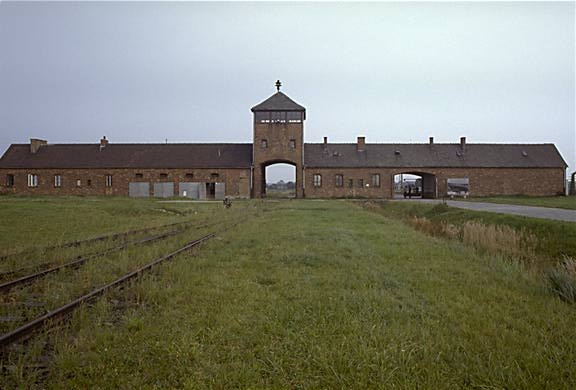 The
Birkenau main entrance
The
Birkenau main entrance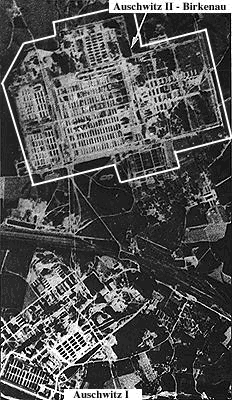
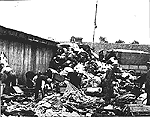
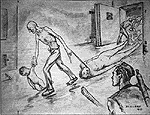 A
Sonderkommando
A
Sonderkommando 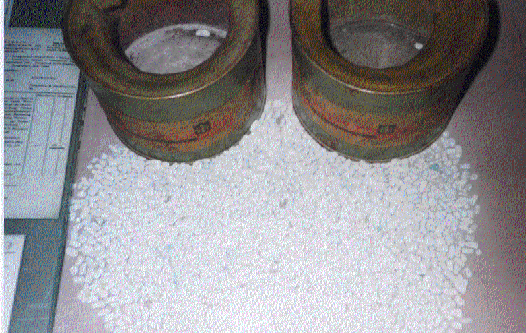 that release a deadly Prussic acid or cyanide gas when
exposed to air. The gas chambers were made underground, right next to
the Crematoriums. They could hold 200 or more
that release a deadly Prussic acid or cyanide gas when
exposed to air. The gas chambers were made underground, right next to
the Crematoriums. They could hold 200 or more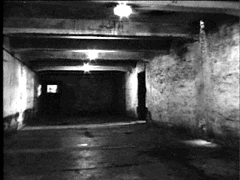 prisoners at a time and
sometimes the chambers were so crowded
prisoners at a time and
sometimes the chambers were so crowded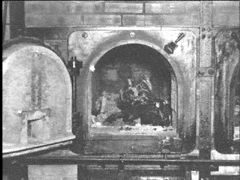 that when the people died they
were still standing. When prisoners were going to be gassed the Germans
told them they were going to take baths because they didn't want the
idea of mass killings to spread through the camp. If the gas chambers
were operating, they would send people to the Crematoriums to be burnt
alive. Five thousand bodies could be burned in Crematoriums II and III a
day and three thousand could be burned in IV and V. In August, 1941
lethal injection began, 30-60 people could die a day. Doctors would say
they were antidotes. Once the shoot was given the victim would have a
seizer and then would die. Before the liberation, the Germans rounded up
prisoners that were strong enough to walk and go for a march. The sick
were left to die. These marches were called "Death Marches".
The Prisoners would be forced to jog or walk for miles. If they would
slow down or just stop, they were shot. Sometimes there would be no
survivors. No one really knows how many people died on the Death
Marches, but like all the other death tolls, it was high. An estimated
guess of four million people died at Auschwitz and there were supposedly
six to eight million who died in the Holocaust, which means about half
of the deaths occurred at Auschwitz.
that when the people died they
were still standing. When prisoners were going to be gassed the Germans
told them they were going to take baths because they didn't want the
idea of mass killings to spread through the camp. If the gas chambers
were operating, they would send people to the Crematoriums to be burnt
alive. Five thousand bodies could be burned in Crematoriums II and III a
day and three thousand could be burned in IV and V. In August, 1941
lethal injection began, 30-60 people could die a day. Doctors would say
they were antidotes. Once the shoot was given the victim would have a
seizer and then would die. Before the liberation, the Germans rounded up
prisoners that were strong enough to walk and go for a march. The sick
were left to die. These marches were called "Death Marches".
The Prisoners would be forced to jog or walk for miles. If they would
slow down or just stop, they were shot. Sometimes there would be no
survivors. No one really knows how many people died on the Death
Marches, but like all the other death tolls, it was high. An estimated
guess of four million people died at Auschwitz and there were supposedly
six to eight million who died in the Holocaust, which means about half
of the deaths occurred at Auschwitz. 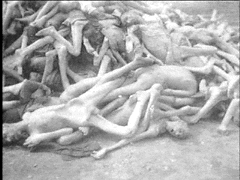
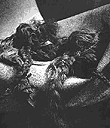 cut off and was used later to make clothes, rugs, or
anything with fabric. The average life span of a woman was about half
of the average man. If the women were going to be shoot, the Nazis
would have them stand naked until it was their turn to be shot. Some
of the woman were raped by the guards and were shot. The guards were
not punished for this crime.
cut off and was used later to make clothes, rugs, or
anything with fabric. The average life span of a woman was about half
of the average man. If the women were going to be shoot, the Nazis
would have them stand naked until it was their turn to be shot. Some
of the woman were raped by the guards and were shot. The guards were
not punished for this crime.